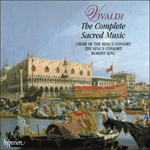
Welcome to Hyperion Records, an independent British classical label devoted to presenting high-quality recordings of music of all styles and from all periods from the twelfth century to the twenty-first.
Hyperion offers both CDs, and downloads in a number of formats. The site is also available in several languages.
Please use the dropdown buttons to set your preferred options, or use the checkbox to accept the defaults.

The ‘Dominus a dextris tuis’ is cast as an energetic duo for tenor and bass. The notion of the Lord ‘striking through kings in the day of his wrath’ is brought out vividly by some virtuosic coloratura passages. For the Day of Judgement (‘Iudicabit in nationibus’) Vivaldi brings back the two trumpets, which begin the movement with seven unaccompanied bars exploring almost the whole of the instrument’s practical compass. Later on, rapid string figurations add greatly to the drama as the Lord continues his work of retribution and destruction.
The alto solo ‘De torrente in via’ brings a welcome touch of peaceful lyricism (semiquaver triplets evoke the rippling of the brook) before an abridged version of the opening movement ushers in the Doxology (‘Gloria Patri’). Vivaldi’s setting of the second part of the Doxology (‘Sicut erat in principio … Amen’) is his most elaborate essay in fugal counterpoint. The eight vocal parts are kept independent throughout, and in many passages the instruments, too, have separate parts. The eight-bar fugue subject, which begins with the ‘germinal motive’, is identical in shape to the opening of the bass in Bach’s ‘Goldberg’ Variations. In fact, this was a popular chaconne bass of the time. The fugal treatment, which causes the ‘bass’ often to migrate to the upper voices, heightens the sense of monumentality and provides a thrilling climax.
from notes by Michael Talbot © 1994
 Vivaldi: The Complete Sacred Music Vivaldi: The Complete Sacred Music‘For King's sterling service to the Vivaldian cause, one of his most important recording and satisfying projects to date, I am thankful’ (Gramophone) ‘If you're waiting for the perfect collection of Vivaldi's sacred music, this is it. It was a happy day when this beautiful boxed set arrived in my m ...» More |

